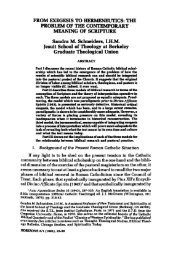WIFE AND SISTER THROUGH THE AGES - Blessed Edmund Rice ...
WIFE AND SISTER THROUGH THE AGES - Blessed Edmund Rice ...
WIFE AND SISTER THROUGH THE AGES - Blessed Edmund Rice ...
Create successful ePaper yourself
Turn your PDF publications into a flip-book with our unique Google optimized e-Paper software.
ιο6SEMEIAPhilo's interpretation leaves little doubt that the immediate text exercisessome control over the shape of the interpretation devised throughthe artful retelling of the story. The text establishes the general sequenceof events and constrains both additions and subtractions from thatsequence. Either to add too much or remove too much is to tell a differentstory, describe a different event. The narrative further stipulates the charactersand again places constraints on the depiction of their relationships.Further, it may lie within the power of the text to establish the illusion ofreference to an actual event which provides the tacit warrant for Philo'ssupplementary additions to the bare biblical narrative. The specific contoursof the narrative composition—its conformity to ordinary chronologicalsequence, the setting of events in identifiable locations, the familiarconcatenation of normal causal relations, the verisimilitude of narratedactions—all comport with the depiction of an ordinary event. More precisely,this text, no less than the sacrifice of Isaac, is composed in such away that it is "fraught with background/' to invoke Erich Auerbach'sseminal reflections on realistic narrative (Auerbach: 12). Foregroundevents are clearly seen and provide the broad shape of the episode, butmuch of what would most interest an actual observer of the event—thecharacters' motives, the relationship of present actions to events beforethis episode, the values to be placed on particular actions—are unexpressed,an invitation and textual warrant for the interpreter'sintervention.It is equally clear that the text's control is not complete. On the broadestplain it has already been mentioned that Philo offers a second, allegoricalinterpretation of the passage, indicating that the realistic contours ofthe narrative do not impose a realistic reading of the narrative. Givingweight to the realistic features of the text, and consequently reading thenarrative as depiction of an actual event, represents a decision, though itwould be wrong to think of the decision as self-conscious or as an arbitrarychoice among options. Philo stands within an interpretive communityin which it is conventional to read such realistic narratives in a literal(της 'ρητής), realistic manner. He follows that convention.Following the realistic convention gives weight in the interpretation tocertain aspects of the text, but, again, does not grant absolute control tothe text. Philo attributes the king's taking Sarai to licentiousness, althoughthe text does not explicitly say so. Sarai is praised for her beauty of soul,although the text does not include this among her virtues. The questionbecomes what governs the direction Philo takes when he goes beyond thetext.There is no single answer. Some of Philo's additions are extensions ofthe realistic elements presented by the text. The description of the famine



